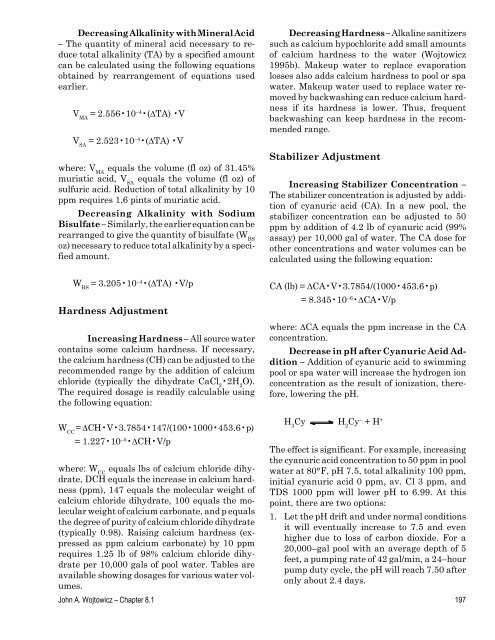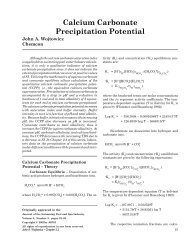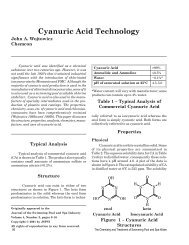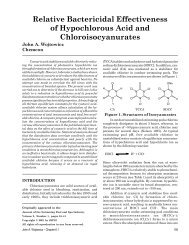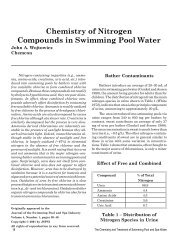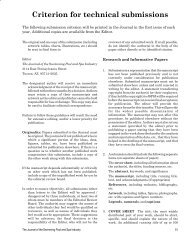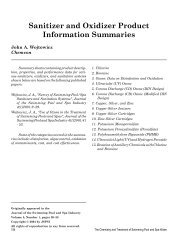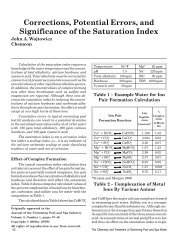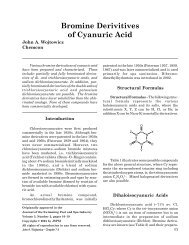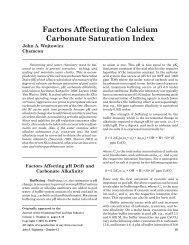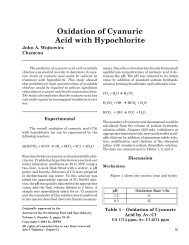Swimming Pool and Spa Water Chemical Adjustments - jspsi
Swimming Pool and Spa Water Chemical Adjustments - jspsi
Swimming Pool and Spa Water Chemical Adjustments - jspsi
Create successful ePaper yourself
Turn your PDF publications into a flip-book with our unique Google optimized e-Paper software.
Decreasing Alkalinity with Mineral Acid<br />
– The quantity of mineral acid necessary to reduce<br />
total alkalinity (TA) by a specified amount<br />
can be calculated using the following equations<br />
obtained by rearrangement of equations used<br />
earlier.<br />
V MA = 2.556•10 – 4 •(∆TA) •V<br />
V SA = 2.523•10 – 4 •(∆TA) •V<br />
where: V MA equals the volume (fl oz) of 31.45%<br />
muriatic acid, V SA equals the volume (fl oz) of<br />
sulfuric acid. Reduction of total alkalinity by 10<br />
ppm requires 1.6 pints of muriatic acid.<br />
Decreasing Alkalinity with Sodium<br />
Bisulfate – Similarly, the earlier equation can be<br />
rearranged to give the quantity of bisulfate (W BS<br />
oz) necessary to reduce total alkalinity by a specified<br />
amount.<br />
W BS = 3.205•10 – 4 •(∆TA) •V/p<br />
Hardness Adjustment<br />
Increasing Hardness – All source water<br />
contains some calcium hardness. If necessary,<br />
the calcium hardness (CH) can be adjusted to the<br />
recommended range by the addition of calcium<br />
chloride (typically the dihydrate CaCl 2 •2H 2 O).<br />
The required dosage is readily calculable using<br />
the following equation:<br />
W CC = ∆CH•V•3.7854•147/(100•1000•453.6•p)<br />
= 1.227•10 – 5 •∆CH•V/p<br />
where: W CC equals lbs of calcium chloride dihydrate,<br />
DCH equals the increase in calcium hardness<br />
(ppm), 147 equals the molecular weight of<br />
calcium chloride dihydrate, 100 equals the molecular<br />
weight of calcium carbonate, <strong>and</strong> p equals<br />
the degree of purity of calcium chloride dihydrate<br />
(typically 0.98). Raising calcium hardness (expressed<br />
as ppm calcium carbonate) by 10 ppm<br />
requires 1.25 lb of 98% calcium chloride dihydrate<br />
per 10,000 gals of pool water. Tables are<br />
available showing dosages for various water volumes.<br />
Decreasing Hardness – Alkaline sanitizers<br />
such as calcium hypochlorite add small amounts<br />
of calcium hardness to the water (Wojtowicz<br />
1995b). Makeup water to replace evaporation<br />
losses also adds calcium hardness to pool or spa<br />
water. Makeup water used to replace water removed<br />
by backwashing can reduce calcium hardness<br />
if its hardness is lower. Thus, frequent<br />
backwashing can keep hardness in the recommended<br />
range.<br />
Stabilizer Adjustment<br />
Increasing Stabilizer Concentration –<br />
The stabilizer concentration is adjusted by addition<br />
of cyanuric acid (CA). In a new pool, the<br />
stabilizer concentration can be adjusted to 50<br />
ppm by addition of 4.2 lb of cyanuric acid (99%<br />
assay) per 10,000 gal of water. The CA dose for<br />
other concentrations <strong>and</strong> water volumes can be<br />
calculated using the following equation:<br />
CA (lb) = ∆CA•V•3.7854/(1000•453.6•p)<br />
= 8.345•10 – 6 •∆CA•V/p<br />
where: ∆CA equals the ppm increase in the CA<br />
concentration.<br />
Decrease in pH after Cyanuric Acid Addition<br />
– Addition of cyanuric acid to swimming<br />
pool or spa water will increase the hydrogen ion<br />
concentration as the result of ionization, therefore,<br />
lowering the pH.<br />
H 3 Cy H 2 Cy – + H +<br />
The effect is significant. For example, increasing<br />
the cyanuric acid concentration to 50 ppm in pool<br />
water at 80°F, pH 7.5, total alkalinity 100 ppm,<br />
initial cyanuric acid 0 ppm, av. Cl 3 ppm, <strong>and</strong><br />
TDS 1000 ppm will lower pH to 6.99. At this<br />
point, there are two options:<br />
1. Let the pH drift <strong>and</strong> under normal conditions<br />
it will eventually increase to 7.5 <strong>and</strong> even<br />
higher due to loss of carbon dioxide. For a<br />
20,000– gal pool with an average depth of 5<br />
feet, a pumping rate of 42 gal/min, a 24– hour<br />
pump duty cycle, the pH will reach 7.50 after<br />
only about 2.4 days.<br />
John A. Wojtowicz – Chapter 8.1 197


